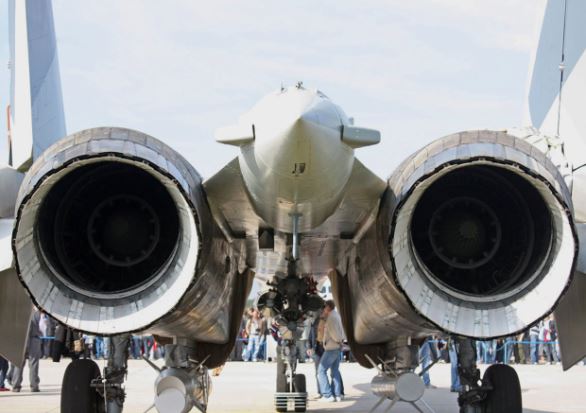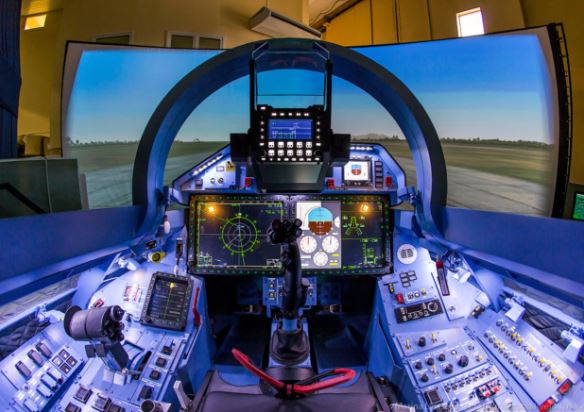Sukhoi Su-35 Fighter Specs, Engine, Cockpit, and Price – Sukhoi Su-35 is a sophisticated multirole air superiority fighter aircraft developed from the Su-27. This aircraft has high maneuverability (+ 9g) with high angle attack, and is equipped with a high-capable weapon system that contributes to the extraordinary air combat capabilities of the new aircraft. The maximum level speed is 2,390 km / h or Mach 2.25. The latest version of the Sukhoi Su-35, Su-35BM (bolshaya modernizatsiya - great modernization).
Sukhoi Su-35 was developed to rival the F-15 Eagle and F-16 Fighting Falcon. This aircraft was developed, tested and introduced into serial production by the Sukhoi Design Bureau, based in Moscow, and produced by KNAPPO from Komsomolsk-on-Amur. The two companies are part of the Sukhoi Aviation Joint Stock Company.
The Su-35 flight test began on February 18, 2008. During a high-speed land test in April 2009, the third prototype of the Su-35 program crashed at Komsomolsk-on-Armur. The accident damaged the new NIIP Irbis-E radar set installed on the Su-35.

High strength, low weight composite materials have been used for non-structural objects such as radomas, nose wheels, front doors and flaps. Some aircraft body structures are made of carbon fiber and aluminum lithium alloys.
Air-to-air missile aircraft can include Vympel R-27 (designation of AA AA-10 Alamo), radar guided mid-range radar Vympel R-77 (AA-12 Enhancer) and infrared infrared-guided Vympel short range R-73E (Archer AA-11).
Air-to-surface missiles include Molniya Kh-29 (AS-14 Kedge) tactical missiles, Kh-31P (AS-17 Krypton) anti-radiation missiles and Kh-58UShE (AS-11 Kilter) long range anti-missile radiation.
Su-35 anti-ship missiles include the Kh-31A, the Kh-59MK long range (AS-18 Kazoo), long-range Kalibr, and the heavy YPO Mashinostroenia long-range missile.
Sukhoi Su-35 can be armed with a number of guided bombs, including TV-guided KAB-500Kr bombs, KAB-500S-E satellite guided bombs, LGB-250 laser guided bombs, bombs guided by TV Kab-1500Kr and KAB laser guide bombs. -1500LG.
The aircraft can also be armed with 80mm, 122mm, 266mm and 420mm rockets. Gryazev-Shipunov 30mm GSh-30-1 weapon is installed in the right wing root with 150 rounds of ammunition.
This suite of aircraft electronic warfare includes a radar warning system, radar jammer, cooperative radar interference system, missile approach warner, laser warner and chaff and flare dispensers.

The total fuel capacity is 14,350l. To increase coverage and higher durability compared to previous models, the Su-35 incorporates additional tailin and root fin tanks. The fuel tank is made of aluminum lithium construction and is located on the wing, fuselage and at the end of the twin tail-tip. The unreferred range of internal fuel is 1,580 km.
For refueling in flight, the aircraft is equipped with a refueling probe on the side of the nose. Two external fuel tanks, the PTB-2000 type, provide an additional 4,000 l of fuel. Ferry range with two external tanks is 4,500 km.
This aircraft can fly with a maximum speed of 2,390 km / hour. The normal range and ferries of each aircraft are 3,600 km and 4,200 km. The maximum height is 18,000 m. The Su-35 weighs around 18,400 kg and the maximum takeoff weight is 34,500 kg.

This aircraft has a quadruplex, digital fly-by-wire control developed by Avionika Moscow Research and Production Complex JSC (MNPK Avionika).
The pilot has two VHF / UHF encrypted radio communication systems and a jammed military data connection system between squadron planes and between aircraft and ground control. The navigation system is based on a digital map display with a strapdown inertial navigation system and a global positioning system.
Su-35 Radar consists of a multimode X-band phased series, Irbis-E, supplied by the Tikhomirov Research Institute for Research-Scientific Design (NIIP), based in Zhukovsky. Irbis-E is a high-performance radar designed for Su-35 aircraft.
The 900mm phase phased array antenna is mounted on a hydraulic actuator for mechanical steering. Electronic steering provides azimuth and 60 ° altitude coverage. With mechanical and electronic scanning the coverage is 120 °.
The radar can detect low and clandestine observable aircraft, unmanned aerial vehicles and missiles with a radar cross section of 0.01 m² at distances of up to 90 km. Radar mode includes air to air, air to land, air to sea, mapping, Doppler rays, and synthetic radar aperture modes. It can detect and track up to 30 airborne targets with a 3m² radar section section (RCS) at a distance of 400 km using track-while-scan mode.
The search control and infrared fire tracking system, OLS-35 IRST, includes infrared sensors, laser scouts, target designers and television cameras. The accuracy of the laser rangefinder is the CEM 5m (probability of circular error), up to a maximum range of 20 km against targets in the air and 30km against targets on land. OLS-35 is a high-performance system with ± 90 ° azimuth and height coverage + 60 ° / -15 °.
The system acquisition range against non-afterburning targets is 50 km forward and 90 km backward. The Su-35 can also be equipped with targeting UOMZ Sapsan and laser designation pods.
The Russian Air Force ordered 48 Sukhoi Su-35 jets in August 2009 with deliveries scheduled to run until 2015. Sukhoi began producing components needed for aircraft assembly in November 2009. The information management system is integrated with the onboard subsystem and new phased arrays. radar systems with detection of long-range air targets have been installed on the aircraft, which are currently undergoing preliminary testing.
Sukhoi Su-35 was developed to rival the F-15 Eagle and F-16 Fighting Falcon. This aircraft was developed, tested and introduced into serial production by the Sukhoi Design Bureau, based in Moscow, and produced by KNAPPO from Komsomolsk-on-Amur. The two companies are part of the Sukhoi Aviation Joint Stock Company.
The Su-35 flight test began on February 18, 2008. During a high-speed land test in April 2009, the third prototype of the Su-35 program crashed at Komsomolsk-on-Armur. The accident damaged the new NIIP Irbis-E radar set installed on the Su-35.

Sukhoi Su-35 Specs
Compared to the design of the Su-27 where it came from, the front body diameter of the Su-35 has been increased to accommodate 900mm diameter antennas larger than the Irbis-E radar.High strength, low weight composite materials have been used for non-structural objects such as radomas, nose wheels, front doors and flaps. Some aircraft body structures are made of carbon fiber and aluminum lithium alloys.
Sukhoi Su-35 Weapons
This aircraft has 12 hardpoints to carry weapons and external stores. Each wing has four sticks - one on the wingtip and three stations under the wing. There are two hard points on the underside of the fuselage in the center line and one under each engine.Air-to-air missile aircraft can include Vympel R-27 (designation of AA AA-10 Alamo), radar guided mid-range radar Vympel R-77 (AA-12 Enhancer) and infrared infrared-guided Vympel short range R-73E (Archer AA-11).
Air-to-surface missiles include Molniya Kh-29 (AS-14 Kedge) tactical missiles, Kh-31P (AS-17 Krypton) anti-radiation missiles and Kh-58UShE (AS-11 Kilter) long range anti-missile radiation.
Su-35 anti-ship missiles include the Kh-31A, the Kh-59MK long range (AS-18 Kazoo), long-range Kalibr, and the heavy YPO Mashinostroenia long-range missile.
Sukhoi Su-35 can be armed with a number of guided bombs, including TV-guided KAB-500Kr bombs, KAB-500S-E satellite guided bombs, LGB-250 laser guided bombs, bombs guided by TV Kab-1500Kr and KAB laser guide bombs. -1500LG.
The aircraft can also be armed with 80mm, 122mm, 266mm and 420mm rockets. Gryazev-Shipunov 30mm GSh-30-1 weapon is installed in the right wing root with 150 rounds of ammunition.
This suite of aircraft electronic warfare includes a radar warning system, radar jammer, cooperative radar interference system, missile approach warner, laser warner and chaff and flare dispensers.

Sukhoi Su-35 Engine
Sukhoi Su-35 is powered by two Sturn / UFA AL-31F 117S turbofan engines with thrust vectoring nozzle controls, each supplying thrust of 86.3kN or 142.2kN with afterburn. The machine was developed jointly by Sukhoi, Saturn and UMPO.The total fuel capacity is 14,350l. To increase coverage and higher durability compared to previous models, the Su-35 incorporates additional tailin and root fin tanks. The fuel tank is made of aluminum lithium construction and is located on the wing, fuselage and at the end of the twin tail-tip. The unreferred range of internal fuel is 1,580 km.
For refueling in flight, the aircraft is equipped with a refueling probe on the side of the nose. Two external fuel tanks, the PTB-2000 type, provide an additional 4,000 l of fuel. Ferry range with two external tanks is 4,500 km.
This aircraft can fly with a maximum speed of 2,390 km / hour. The normal range and ferries of each aircraft are 3,600 km and 4,200 km. The maximum height is 18,000 m. The Su-35 weighs around 18,400 kg and the maximum takeoff weight is 34,500 kg.

Sukhoi Su-35 Cockpit and Avionics
Sukhoi Su-35 cockpit is equipped with two high resolution 230mm x 305mm MFI-35 liquid crystal screens with a multifunctional control panel and IKSh-1M main screen with a wide viewing area of 20 ° x 30 °. The cockpit has a central control column and is equipped with a zero-zero Zvesda K-36D-3.5E ejection seat that allows the pilot to launch zero speed and zero altitude.This aircraft has a quadruplex, digital fly-by-wire control developed by Avionika Moscow Research and Production Complex JSC (MNPK Avionika).
The pilot has two VHF / UHF encrypted radio communication systems and a jammed military data connection system between squadron planes and between aircraft and ground control. The navigation system is based on a digital map display with a strapdown inertial navigation system and a global positioning system.
Su-35 Radar consists of a multimode X-band phased series, Irbis-E, supplied by the Tikhomirov Research Institute for Research-Scientific Design (NIIP), based in Zhukovsky. Irbis-E is a high-performance radar designed for Su-35 aircraft.
The 900mm phase phased array antenna is mounted on a hydraulic actuator for mechanical steering. Electronic steering provides azimuth and 60 ° altitude coverage. With mechanical and electronic scanning the coverage is 120 °.
The radar can detect low and clandestine observable aircraft, unmanned aerial vehicles and missiles with a radar cross section of 0.01 m² at distances of up to 90 km. Radar mode includes air to air, air to land, air to sea, mapping, Doppler rays, and synthetic radar aperture modes. It can detect and track up to 30 airborne targets with a 3m² radar section section (RCS) at a distance of 400 km using track-while-scan mode.
The search control and infrared fire tracking system, OLS-35 IRST, includes infrared sensors, laser scouts, target designers and television cameras. The accuracy of the laser rangefinder is the CEM 5m (probability of circular error), up to a maximum range of 20 km against targets in the air and 30km against targets on land. OLS-35 is a high-performance system with ± 90 ° azimuth and height coverage + 60 ° / -15 °.
The system acquisition range against non-afterburning targets is 50 km forward and 90 km backward. The Su-35 can also be equipped with targeting UOMZ Sapsan and laser designation pods.
Sukhoi Su-35 Price and Orders
The price of the latest Su-35 fighter aircraft is around US $ 45 - 65 million. The first Su-35 aircraft was handed over to the State Flight Test Center (GLITS) to 929 for flight testing in August 2011. The Russian Ministry of Defense received six Su-35 production aircraft from Sukhoi in December 2012.The Russian Air Force ordered 48 Sukhoi Su-35 jets in August 2009 with deliveries scheduled to run until 2015. Sukhoi began producing components needed for aircraft assembly in November 2009. The information management system is integrated with the onboard subsystem and new phased arrays. radar systems with detection of long-range air targets have been installed on the aircraft, which are currently undergoing preliminary testing.








Mach speeds - 2,450 km/h is mach2.0 , you state max level speed is 2,390 km p/h.So, the plane is sub 2.0 NOT as you state mach2.2? or some discrepancy.
ReplyDeletehttps://www.metric-conversions.org/speed/mach-to-kilometers-per-hour.htm